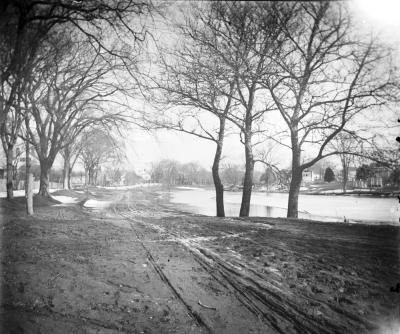The Mast-Head: On the Village Green

Those returning to East Hampton after a time away will be sure to notice that the green near the flagpole does not look quite the same. Where until this year it was unbroken grass, a winding ribbon of plants and low shrubs now extends to the little bridge on Mill Road. This, we are told, is a bioswale, which is, as I told a group of Ladies Village Improvement Society members in a recent talk, a fancy word for swamp. This brought a laugh, as one of the next speaker’s topics was to be the Village Green and how it recently came to look different.
So it was in time past. In his 1849 history, Henry P. Hedges said what is now Town Pond was not a pond exactly, when East Hampton was founded 200 years earlier. “There was no collection of water, and a swamp or marsh covered the centre of the street.” Like today’s bioswale of native plants, “a small rivulet or drain communicated with and ran into the swamp from the north,” Hedges wrote.
The swamp was soon to be changed. In June 1653, according to town records, “a watering pond” was “diged at the Spring Eastward.” Around this, the English were already building houses and setting out their plantation, as they called it, and their bodies were relegated to the earth in the South End Burying Ground there. The second and more substantial church was built in 1717 along the rivulet’s bank, where the newest wing of Guild Hall stands in all its concrete-block anonymity across from the Star office.
Maidstone, as the plantation was first called, existed independently of other European outposts for a time, but the founders relatively soon voted it under the authority of the Connecticut Colony. There was little interaction with the Dutch who lived at New Amsterdam far to the west; it was difficult to reach, for one thing, and far easier to sail across the Sound when the need arose for trade or to adjudicate a complicated legal matter.
In the first division of land, 34 allotments were divvied up around what would become Town Pond, the parcels long and narrow and between 8 and 12 acres each. The first laws that might be considered precursors to today’s zoning rules came early, too: In 1650, the town trustees declared, “yt whosoever shall take up a lot in Towne shal live upon it himselfe and also yt no man shal sell his alotment or any part thereof.”
For more than 200 years, the area around Town Pond was mostly a mudhole. Main Street, in an old glass-plate negative I found at an estate sale at its north end some time ago, appears a soggy mess of cart wheel ruts and horse hoof divots. The Village Green — and Hook Pond, into which it eventually drains — has long been a cache basin for what runs off the street or leaks through the groundwater.
The village occasionally still hires wader-clad baymen to rid it of algae mats when they get unsightly. The recent bioswale is an effort to slow runoff as it heads toward the pond. Its plants will help that process, their roots taking up moisture and creating an underground net to trap contaminants, I suppose.
I find the appearance of the now-planted bioswale appealing, though I detest the word. And I am keeping an eye out to see what birds and other wildlife will show up there. Whether it will be adequate by itself to improve Town and Hook Ponds’ water quality, I don’t know, but it is a nice reminder of how things were when a rivulet ran the length of a soggy Main Street to communicate with a swamp at the north.
